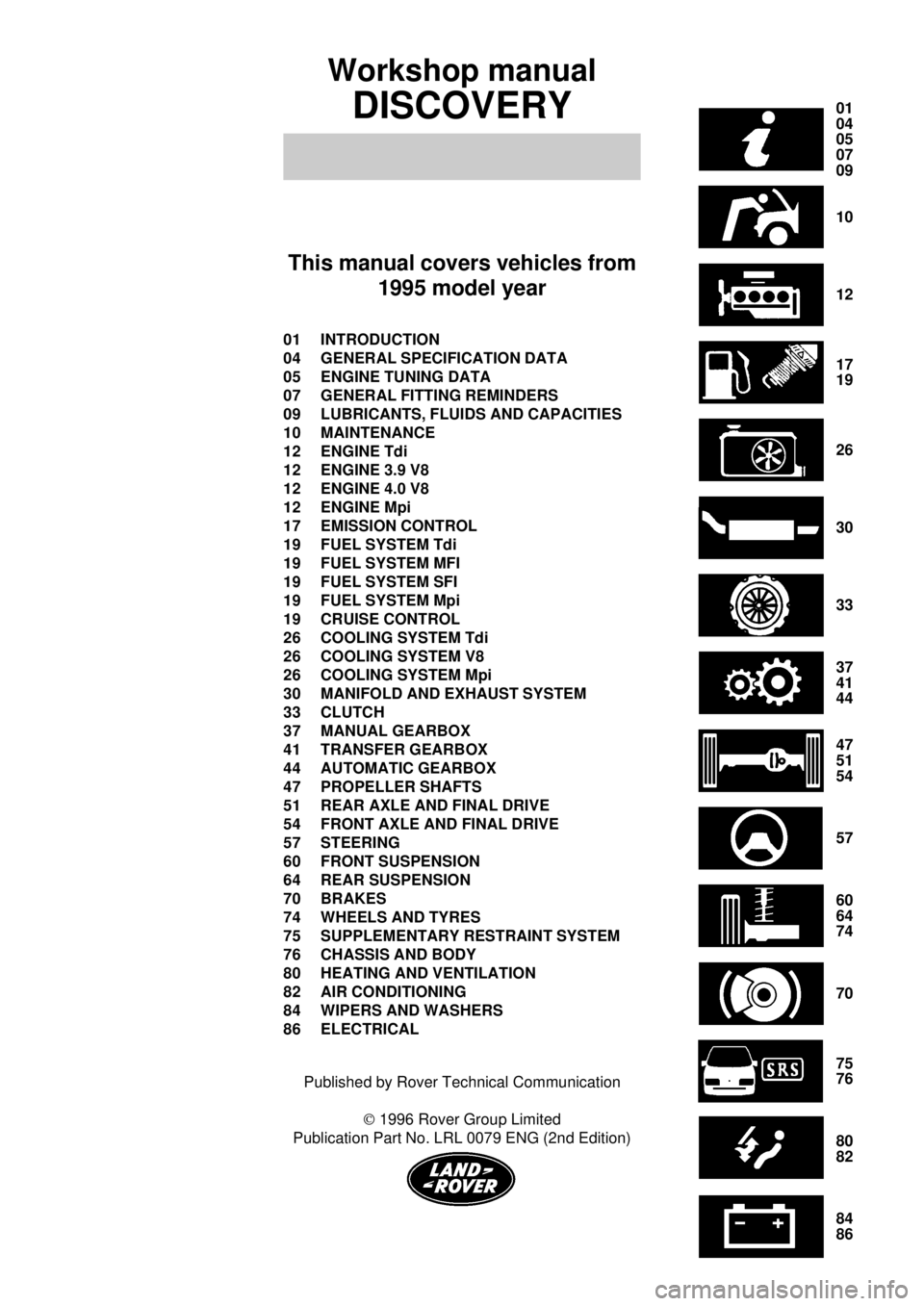1995 LAND ROVER DISCOVERY fuel
[x] Cancel search: fuelPage 2 of 976

01
04
05
07
09
10
12
17
19
26
30
33
37
41
44
47
51
54
57
60
64
74
70
75
76
80
82
84
86
Workshop manual
DISCOVERY
This manual covers vehicles from
1995 model year
01 INTRODUCTION
04 GENERAL SPECIFICATION DATA
05 ENGINE TUNING DATA
07 GENERAL FITTING REMINDERS
09 LUBRICANTS, FLUIDS AND CAPACITIES
10 MAINTENANCE
12 ENGINE Tdi
12 ENGINE 3.9 V8
12 ENGINE 4.0 V8
12 ENGINE Mpi
17 EMISSION CONTROL
19 FUEL SYSTEM Tdi
19 FUEL SYSTEM MFI
19 FUEL SYSTEM SFI
19 FUEL SYSTEM Mpi
19 CRUISE CONTROL
26 COOLING SYSTEM Tdi
26 COOLING SYSTEM V8
26 COOLING SYSTEM Mpi
30 MANIFOLD AND EXHAUST SYSTEM
33 CLUTCH
37 MANUAL GEARBOX
41 TRANSFER GEARBOX
44 AUTOMATIC GEARBOX
47 PROPELLER SHAFTS
51 REAR AXLE AND FINAL DRIVE
54 FRONT AXLE AND FINAL DRIVE
57 STEERING
60 FRONT SUSPENSION
64 REAR SUSPENSION
70 BRAKES
74 WHEELS AND TYRES
75 SUPPLEMENTARY RESTRAINT SYSTEM
76 CHASSIS AND BODY
80 HEATING AND VENTILATION
82 AIR CONDITIONING
84 WIPERS AND WASHERS
86 ELECTRICAL
Published by Rover Technical Communication
Ó1996 Rover Group Limited
Publication Part No. LRL 0079 ENG (2nd Edition)
Page 3 of 976

INTRODUCTION
1
INFORMATION INTRODUCTION
This workshop manual covers vehicles from 1995
model year onwards. Amendments and additional
pages will be issued to ensure that the manual
covers latest models. Amendments and additions
will be identified by the addition of a dated footer
at the bottom of the page.
This Workshop Manual is designed to assist skilled
technicians in the efficient repair and maintenance of
Land Rover vehicles.
Individuals who undertake their own repairs
should have some skill and training, and limit
repairs to components which could not affect the
safety of the vehicle or its passengers. Any
repairs required to safety critical items such as
steering, brakes, suspension or supplementary
restraint system should be carried out by a Land
Rover Dealer. Repairs to such items should
NEVER be attempted by untrained individuals.
WARNINGS, CAUTIONSandNOTESare given
throughout this Manual in the following form:
WARNING: Procedures which must be
followed precisely to avoid the possibility
of personal injury.
CAUTION: This calls attention to
procedures which must be followed to
avoid damage to components.
NOTE: This calls attention to methods
which make a job easier or gives helpful
information.
DIMENSIONS
The dimensions quoted are to design engineering
specification. Alternative unit equivalents, shown in
brackets following the dimensions, have been
converted from the original specification.REFERENCES
References to the left or right hand side in the manual
are made when viewing the vehicle from the rear.
With the engine and gearbox assembly removed, the
water pump end of the engine is referred to as the
front.
To reduce repetition, some operations covered in this
Manual do not include reference to testing the vehicle
after repair.
It is essential that work is inspected and tested after
completion and if necessary a road test of the vehicle
is carried out particularly where safety related items
are concerned.
REPAIRS AND REPLACEMENTS
When replacement parts are required it is essential
that Land Rover parts are used.
Attention is particularly drawn to the following points
concerning repairs and the fitting of replacement parts
and accessories: Safety features embodied in the
vehicle may be impaired if other than Land Rover
parts are fitted. In certain territories, legislation
prohibits the fitting of parts not to the vehicle
manufacturer's specification. Torque spanner values
given in the Workshop Manual must be strictly
adhered to. Locking devices, where specified, must be
fitted. If the efficiency of a locking device is impaired
during removal it must be replaced with a new one.
Certain fasteners must not be re-used. These
fasteners are specified in the Workshop Manual.
POISONOUS SUBSTANCES
Many liquids and other substances used are
poisonous and therefore must not be consumed. It is
also advisable to keep all substances away from open
wounds. These substances among others include
anti-freeze, brake fluid, fuel, windscreen washer
additives, air conditioning refrigerant, lubricants and
various adhesives.
Page 4 of 976

01INTRODUCTION
2
INFORMATION FUEL HANDLING PRECAUTIONS
The following information provides basic precautions
which must be observed if fuel is to be handled safely.
It also outlines the other areas of risk which must not
be ignored.
This information is issued for basic guidance only, and
in any case of doubt, appropriate enquiries should be
made of your local Fire Officer or Fire Department.
Fuel vapour is highly flammable and in confined
spaces is also very explosive and toxic.
When fuel evaporates it produces 150 times its own
volume in vapour, which when diluted with air
becomes a readily ignitable mixture. The vapour is
heavier than air and will always fall to the lowest level.
It can readily be distributed throughout a workshop by
air current, consequently, even a small spillage of fuel
is very dangerous.
Always have a fire extinguisher containingFOAM CO
2
GAS,orPOWDERclose at hand when handling fuel,
or when dismantling fuel systems and in areas where
fuel containers are stored.
WARNING: lt is imperative that the battery
is not disconnected during fuel system
repairs as arcing at the battery terminal
could ignite fuel vapour in the atmosphere.
Always disconnect the vehicle battery BEFORE
carrying out work on the fuel system.
Whenever fuel is being handled, transferred or
stored, or when fuel systems are being dismantled
all forms of ignition must be extinguished or
removed, any leadlamps used must be flame proof
and kept clear of spillage.
No one should be permitted to repair components
associated with fuel without first having had fuel
system training.Hot fuel handling precautions
WARNING: Before commencing any
operation requiring fuel to be drained from
the fuel tank, the following procedure must
be adhered to:
1.Allow sufficient time for the fuel to cool, thus
avoiding contact with hot fuels.
2.Vent the system by removing the fuel filler cap in
a well ventilated area. Refit the filler cap until the
commencement of fuel drainage.
Fuel transfer
WARNING: Fuel must not be extracted or
drained from any vehicle while it is
standing over a pit.
The transfer of fuel from the vehicle fuel tank must be
carried out in a well ventilated area. An approved
transfer tank must be used according to the transfer
tank manufacturer's instructions and local regulations,
including attention to grounding of tanks.
Fuel tank removal
AFUEL VAPOURwarning label must be attached to
the fuel tank upon removal from the vehicle.
Fuel tank repair
Under no circumstances should a repair to any tank
be attempted.
Page 5 of 976

INTRODUCTION
3
INFORMATION SYNTHETIC RUBBER
Many '0' ring seals, flexible pipes and other similar
items which appear to be natural rubber are made of
synthetic materials called Fluoroelastomers. Under
normal operating conditions this material is safe, and
does not present a health hazard. However, if the
material is damaged by fire or excessive heat, it can
break down and produce highly corrosive Hydrofluoric
acid which can cause serious burns on contact with
skin. Should the material be in a burnt or overheated
condition handle only with seamless industrial gloves.
Decontaminate and dispose of the gloves immediately
after use.
If skin contact does occur, remove any contaminated
clothing immediately and obtain medical assistance
without delay. In the meantime, wash the affected
area with copious amounts of cold water or limewater
for fifteen to sixty minutes.
RECOMMENDED SEALANTS
A number of branded products are recommended in
this manual for use during maintenance and repair
work.
These items include:
HYLOMAR GASKET AND JOINTING COMPOUND
and
HYLOSIL RTV SILICON COMPOUND.
They should be available locally from garage
equipment suppliers. If there is any problem obtaining
supplies, contact the following company for advice
and the address of the nearest supplier.
MARSTON LUBRICANTS LTD.
Hylo House,
Cale Lane,
New Springs,
Wigan WN2 1JR
Tel 01942 824242USED ENGINE OIL
WARNING: Prolonged and repeated
contact with engine or motor oil will result
in the removal of natural fats from the
skin, leading to dryness, irritation and dermatitis.
Used engine oil contains potentially harmful
contaminants which may cause skin cancer.
Adequate means of skin protection and washing
facilities should be provided.
Handling precautions
1.Avoid prolonged and repeated contact with oils,
particularly used engine oils.
2.Wear protective clothing, including impervious
gloves where applicable.
3.Do not put oily rags in pockets.
4.Avoid contaminating clothes, particularly
underwear, with oil.
5.Overalls must be cleaned regularly. Discard
unwashable clothing and oil impregnated
footwear.
6.First aid treatment must be obtained immediately
for open cuts and wounds.
7.Use barrier creams, before each work period, to
help the removal of oil from the skin.
8.Wash with soap and water to ensure all oil is
removed (skin cleansers and nail brushes will
help). Preparations containing lanolin replace the
natural skin oils which have been removed.
9.Do not use gasoline, kerosene, diesel fuel,
petrol, thinners or solvents for washing the skin.
10.If skin disorders develop, obtain medical advice.
11.Where practicable, degrease components prior
to handling.
12.Where there is a risk of eye contact, eye
protection should be worn, for example, goggles
or face shields; in addition an eye wash facility
should be provided.
Disposing of used oils
Environmental protection precaution
It is illegal to pour used oil onto the ground, down
sewers or drains, or into waterways.
Dispose of used oil through authorised waste disposal
contractors. If in doubt contact your Local Authority for
advice on disposal facilities.
Page 7 of 976

INTRODUCTION
5
INFORMATION JACKING
The following instructions must be carried out before
raising the vehicle off the ground.
1.Use a solid level ground surface.
2.Apply parking brake.
3.Select 'P' or 1st gear in main gearbox.
4.Select Low range in transfer gearbox.
CAUTION: To avoid damage occurring to
the under body components of the vehicle
the following jacking procedures must be
adhered to.
DO NOT POSITION JACKS OR AXLE STANDS
UNDER THE FOLLOWING COMPONENTS.
Body structure
Bumpers
Fuel lines
Brake lines
Front radius arms
Panhard rod
Steering linkage
Rear Trailing links
Fuel tank
Engine sump
Gearbox bell housing
Jack or support vehicle by axles only.Vehicle jack
The jack provided with the vehicle is only intended to
be used in an emergency, for changing a tyre. Do
NOTuse the jack for any other purpose. Refer to
Owner's Manual for vehicle jack location points and
procedure. Never work under a vehicle supported by
the vehicle jack.
Hydraulic jack
A hydraulic jack with a minimum 1500 kg, 3,300 lbs
load capacity must be used.
CAUTION: Do not commence work on the
underside of the vehicle until suitable axle
stands have been positioned under the
axle.
Raise the front of the vehicle
1.Position cup of hydraulic arm under differential
casing.
NOTE: The differential casing is not
central to the axle. Care should be taken
when raising the front road wheels off the
ground as the rear axle has less sway stiffness.
Page 12 of 976

01INTRODUCTION
10
INFORMATION ABBREVIATIONS AND SYMBOLS USED IN THIS
MANUAL
Across flats (bolt size) AF............................................
After bottom dead centre ABDC...................................
After top dead centre ATDC.........................................
Alternating current a.c..................................................
Ampere amp................................................................
Ampere hour amp hr....................................................
Before bottom dead centre BBDC................................
Before top dead centre BTDC......................................
Bottom dead centre BDC.............................................
Brake horse power bhp................................................
British Standards BS....................................................
Carbon monoxide CO..................................................
Centimetre cm.............................................................
Centigrade (Celsius) C................................................
Cubic centimetre cm
3...................................................
Cubic inch in3...............................................................
Degree (angle) deg or° ...............................................
Degree (temperature) deg or° .....................................
Diameter dia................................................................
Direct current d.c..........................................................
Electronic Control Unit ECU........................................
Electronic Fuel Injection EFI........................................
Fahrenheit F.................................................................
Feet ft...........................................................................
Feet per minute ft/min..................................................
Fifth 5th........................................................................
First 1st........................................................................
Fluid ounce fl oz..........................................................
Foot pounds (torque) lbf ft............................................
Fourth 4th.....................................................................
Gramme (force) gf........................................................
Gramme (mass) g........................................................
Gallons gal...................................................................
Gallons (US) US gal.....................................................
High tension (electrical) H.T.........................................
Internal diameter I.D....................................................
Inches of mercury in. Hg..............................................
Inches in......................................................................
Kilogramme (force) kgf.................................................
Kilogramme (mass.) kg................................................
Kilogramme centimetre (torque) kgf.cm.......................
Kilogramme per square millimetre kgf/mm
2.................
Kilogramme per square centimetre kgf/cm2.................
Kilogramme metres (torque) kgf.m..............................
Kilometres km..............................................................
Kilometres per hour km/h.............................................
Kilovolts kV...................................................................
Left-hand LH................................................................
Left-hand steering LHStg.............................................
Left-hand thread LHThd...............................................
Litres litre.....................................................................Low tension l.t..............................................................
Maximum max.............................................................
Metre m........................................................................
Millilitre ml....................................................................
Millimetre mm...............................................................
Miles per gallon mpg....................................................
Miles per hour mph......................................................
Minute (angle) '............................................................
Minus (of tolerance) -...................................................
Negative (electrical) -...................................................
Newton metres (torque) Nm........................................
Number No..................................................................
Ohms ohm...................................................................
Ounces (force) ozf.......................................................
Ounces (mass) oz........................................................
Ounce inch (torque) ozf.in...........................................
Outside diameter O.D..................................................
Part number Part No....................................................
Percentage %...............................................................
Pints pt.........................................................................
Pints (US) US pt...........................................................
Plus (tolerance) +.........................................................
Positive (electrical) +....................................................
Pound (force) lbf..........................................................
Pounds inch (torque) in.lbf...........................................
Pound (mass) lb...........................................................
Pounds per square inch P.S.I......................................
Ratio :...........................................................................
Reference ref...............................................................
Revolution per minute rev/min.....................................
Right-hand RH.............................................................
Second (angle) "...........................................................
Second (numerical order) 2nd......................................
Specific gravity sp.gr....................................................
Square centimetres cm
2...............................................
Square inches in2.........................................................
Standard wire gauge s.w.g..........................................
Synchroniser/Synchromesh synchro...........................
Third 3rd.......................................................................
Top dead centre TDC..................................................
United Kingdom UK......................................................
Vehicle Identification Number VIN...............................
Volts V.........................................................................
Watts W.......................................................................
SCREW THREADS
American Standard Taper Pipe NPTF.........................
British Standard Pipe BSP...........................................
Unified Coarse UNC....................................................
Unified Fine UNF.........................................................
Page 13 of 976

INTRODUCTION
11
INFORMATION CROSS REFERENCE OF EMISSION SYSTEM
TERMINOLOGY
NEW TERM (ACRONYM)
Accelerator pedal (AP).................................................
Air cleaner (ACL)..........................................................
Air conditioning (AC)....................................................
Battery positive voltage (B+)........................................
Closed loop (CL)..........................................................
Closed throttle position (CTP)......................................
Canister purge valve (CANPV)....................................
Data link connector (DLC)...........................................
Diagnostic trouble code (DTC).....................................
Distributor ignition (DI).................................................
Engine control module (ECM)......................................
Engine coolant level (ECL)...........................................
Engine coolant temperature (ECT)..............................
Engine coolant temperature sensor (ECTS)................
Engine speed (RPM)....................................................
Evaporative emission system (EVAP)..........................
Engine fuel temperature sensor (EFTS)......................
4th gear, 3rd gear etc. (4GR, 3GR)..............................
Fuel pump (FP)............................................................
Fan control module (FCM)...........................................
Generator (GEN)..........................................................
Ground (GND)..............................................................
Heated oxygen sensor (H02S)....................................
Idle air control (IAC)......................................................
Idle air control valve (IACV).........................................
Ignition control module (ICM).......................................
Inertia fuel shutoff (IFS)................................................
Inertia fuel shutoff switch (IFSS)..................................
Intake air temperature (IAT).........................................
Malfunction indicator lamp (MIL)..................................
Manifold vacuum zone (MVZ)......................................
Mass air flow sensor (MAFS).......................................
Multiport fuel injection (MFI)........................................
On board diagnostic (OBD)..........................................
Open loop (OL)............................................................
Park/neutral position (PNP).........................................
Park/neutral position switch (PNPS)............................
Programmable read only memory (PROM)..................
Relay module (RM)......................................................
Service reminder indicator (SRI)..................................
Solid state relay module (SSRM).................................
Three way catalytic converter (TWC)..........................
Throttle body (TB)........................................................
Throttle position sensor (TPS)......................................
Torque converter clutch (TCC)....................................
Transmission range (TR)..............................................
Transmission range selector (TRS).............................
Vehicle speed sensor (VSS)........................................
Wide open throttle (WOT)............................................OLD TERM (ACRONYM)
Throttle pedal (-)..........................................................
Air cleaner (-)...............................................................
Air conditioning (AC)....................................................
Battery plus, bat +, bat feed (B+).................................
Closed loop (-).............................................................
Closed throttle, idle position (-)....................................
Charcoal canister purge valve (-).................................
Serial link (-)................................................................
Fault code (-)...............................................................
Electronic ignition (-)....................................................
Electronic control unit (ECU)........................................
Coolant level (-)...........................................................
Coolant temperature (temp).........................................
Coolant temperature thermistor (-)..............................
Engine speed (rev/min)................................................
Evaporative loss system (ELC)...................................
Fuel temperature thermistor (-)....................................
Fourth gear, 3rd gear (-)..............................................
Fuel pump (-)...............................................................
Condenser fan timer (-)................................................
Alternator (-)................................................................
Ground, earth (B-)........................................................
Lambda (02) sensor (-)................................................
Idle speed control (ISC)................................................
Stepper motor (-).........................................................
Ignition module (-)........................................................
Inertia switch (-)...........................................................
Inertia switch (-)...........................................................
Intake temperature/ambient temperature (-)................
EFI warning lamp (-)....................................................
Manifold depression, vacuum (-).................................
Air flow meter (-)..........................................................
Electronic fuel injection (EFI).......................................
Fault code display unit (-)............................................
Open loop (-)...............................................................
Park or neutral (-).........................................................
Start inhibit switch (-)...................................................
Chip, PROM (PROM)...................................................
Relay (-).......................................................................
Check engine light (-)...................................................
Control unit (-)..............................................................
Catalyst, catalytic converter (CAT)..............................
Throttle housing (-)......................................................
Throttle potentiometer (-).............................................
Direct drive clutch (DDC)..............................................
Transmission gear (-)...................................................
Shift lever, shifter (-)....................................................
Road speed transducer (-)...........................................
Full throttle, wide open throttle (WOT).........................
Page 23 of 976

GENERAL SPECIFICATION DATA
5
INFORMATION FUEL SYSTEM 3.9 V8i
Fuel system type Lucas 14CUX hot wire system electronically controlled..............................................................
Fuel pump-make/type ACX delco high pressure electrical, immersed in the......................................................
fuel tank
Fuel pump delivery pressure 2.4-2.6 bar (34-37 lbf/in
2) ............................................
Fuel filter Bosch in-line filter 'canister' type..........................................................................
Airflow Sensor
Make and type Lucas 'Hot Wire' 5AM.................................................................
Injectors
Make and type Lucas 8NJ.................................................................
Electronic Control Unit
Make and type Lucas 14CUX.................................................................
Fuel pressure regulator
Make and type Lucas 8RV.................................................................
Fuel temperature sensor
Make and type Lucas 6TT.................................................................
Coolant temperature sensor
Make and type Lucas 3TT.................................................................
Bypass Airvalve (Stepper motor)
Make and type Lucas 2ACM.................................................................
Throttle potentiometer
Make and type Lucas 215SA.................................................................
Lambda sensor - catalyst vehicles
Make and type Lucas 3LS.................................................................